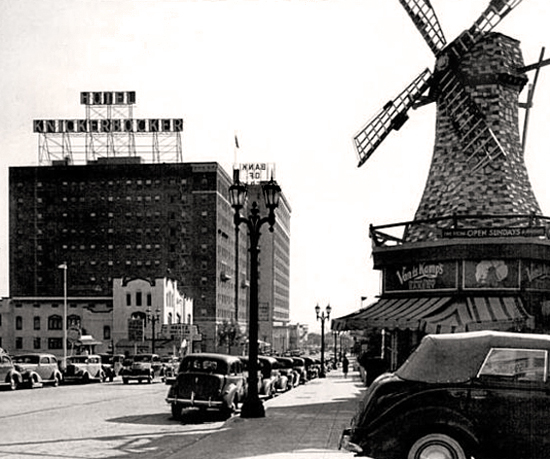July 29, 2013
Frankenstein's Windmill
A 1940 photo shows the Van de Kamp Dutch Bakery sitting at
the corner of Ivar and Yucca in Los Angeles. That’s the Knickerbocker Hotel
across the street, once a Hollywood hot spot that fell on hard times before
being saved and converted into housing for senior citizens.
In the Spring of 1931, working with writer
Garrett Fort, Robert Florey — the first director attached to Universal’s Frankenstein — wrote a script that would serve as a template for
the shooting script reworked under James Whale, who took over the project
in June. Among Florey’s surviving contributions were the crucial brain switch
and the atmospheric denouement in an old windmill where The Monster dragged its
creator, with bloodhounds and torch-wielding villagers in frantic pursuit. In
later years, Florey would reveal that his windmill finale had been inspired by
the Van de Kamp building seen from his apartment on Ivar Street.
The film’s now iconic windmill provided an improbable but
perfect, exotic setting for the film’s frenzied finale, the building itself
dangerous with its creaky cogs and forbidding sails. When Frankenstein is
thrown off the high balcony, the brutal fall was originally meant to be fatal.
After the film wrapped, actor Colin Clive headed home to England proud that
Universal had been bold enough to kill off its title character, but soon
thereafter, an additional scene was shot with Clive and Mae Clarke spelled by
stand-ins, showing the faithful Elizabeth nursing her poor Henry back to
health, and available for a sequel. As for The Monster, he is last seen
panicked out of his mind, pinned under a heavy wooden beam as fire laps around
him. The follow-up, Bride of Frankenstein (1935), picks up at the windmill in smoking ruins where The Monster, burned and
bruised, was saved when the structure collapsed into an underground pool.
Frankenstein’s windmill has been referenced in films,
notably in the rip-roaring black and white opening scenes of the otherwise
ghastly Van Helsing (2004). Director Tim
Burton evokes the windmill as a miniature golf set in the original Frankenweenie short of 1984 and again as a hilltop building in the
2012 feature film version. There is also a spectacular and unmistakably
Frankensteinian windmill in Burton’s Sleepy Hollow (1999).
Van de Kamp’s Holland Dutch Bakers was founded in 1915, soon
sprouting a chain of stores and coffee shops with distinctive windmill facades
and waitresses dressed as Dutch maidens complete with starched caps and
decorative aprons. In the Forties, new buildings were streamlined, its
windmills outlined in neon. The kooky architecture was eventually abandoned
altogether, the bakeries operating out of regular buildings with a blue
windmill motif appearing on logos. Van de Kamp’s changed hands a couple of
times before collapsing into bankruptcy in 1990. The name survives in some
areas as a supermarket brand for frozen foods.
The site of the “Frankenstein windmill” at Ivar and Yucca is
currently occupied by Joseph’s Café, a restaurant and dance bar. In the Google
Map photo above, the domed structure at left is where the Windmill originally
stood.
•
04:30
![]()
Labels: • Frankenstein (1931), Places
Subscribe to:
Post Comments (Atom)







No comments:
Post a Comment